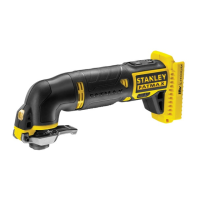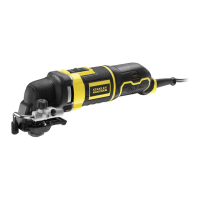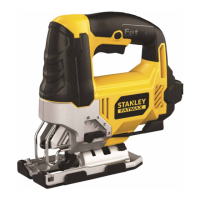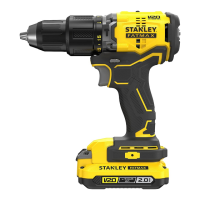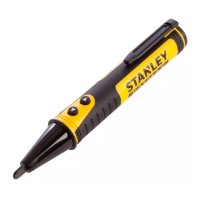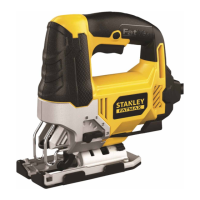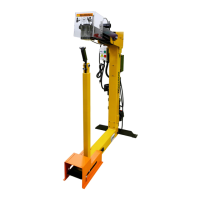13
ENGLISH
(Original instructions)
Note!Should nails continue to jam frequently in contact trip,
have tool serviced by an authorized STANLEY FATMAX
service center.
Cold Weather Operation
When operating tools at temperatures below freezing:
u Keep tool as warm as possible prior to use.
u Actuate the tool 5 or 6 times into scrap lumber before
using.
Hot Weather Operation
Tool should operate normally. However, keep tool out of direct
sunlight as excessive heat can deteriorate bumpers and other
rubber parts resulting in increased maintenance.
No-mar tip (Fig. O)
The tool comes equipped with a spare no-mar tip (19) located
on the side of the nail magazine.
To replace the no-mar pad, simply pull off the old no-mar pad
and ret the new no-mar pad onto the contact trip (8).
Replacement parts
Warning!To reduce the risk of personal injury, disconnect
battery pack from tool and engage trigger lock-off before
performing maintenance, or clearing a jammed nail.
The tool comes equipped with a spare no mar tip located on
the side of the nail magazine.
Use only identical replacement parts. For a parts list or to
order parts, visit our service website at www.stanley.eu/3co.
uk. You can also order parts from your nearest
STANLEY FATMAX Factory Service Center or STANLEY
FATMAX Authorized Warranty.
Accessories
Warning! Since accessories, other than those offered by
STANLEY FATMAX, have not been tested with this product,
use of such accessories with this tool could be hazardous.
To reduce the risk of injury, only STANLEY FATMAX
recommended accessories should be used with this product.
Recommended accessories for use with your tool are
available at extra cost from your local dealer or authorized
service center.
Troubleshooting
If your appliance seems not to operate properly, follow the
following instructions.
If this does not solve the problem, please contact your local
STANLEY FATMAX repair agent.
Warning! Before proceeding, unplug the appliance.
Problem Possible Cause Possible Solution
Unit will not start. Battery pack not
installed properly.
Battery pack not
charged.
Trigger lock-off is
engaged.
Check battery pack
installation.
Check battery pack charging
requirements.
Disengage trigger lock-off.
Tool doesn’t
actuate.
(Headlights on,
motor does not
run)
Motor stops running
after 2 seconds.
Normal operation; release
trigger or contact trip and
re-depress.
Tool doesn’t
actuate.
(Headlights
ash)
Low battery charge or
damaged battery.
Charge or replace battery.
Tool doesn’t
actuate.
(Headlights ash
continuously)
Jammed fastener / tool
stalled.
Jammed mechanism
Remove the battery, rotate the
stall release lever. Clear the
jammed fastener, and reinsert
battery pack.
See authorized service center.
Tool doesn’t
actuate.
((Headlights on,
motor runs,
driver blade
stuck down)
See authorized service center.
Tool operates,
but does
not drive the
fastener fully.
Low battery charge or
damaged battery.
Depth adjustment set
too shallow.
Tool not rmly applied
to workpiece.
Material and fastener
length too rigorous an
application.
Charge or replace battery.
Rotate depth adjustment
wheel to
a deeper setting.
Read instruction manual.
Choose appropriate material
or fastener length.
Maintenance
Your STANLEY FATMAX corded/cordless appliance/tool has
been designed to operate over a long period of time with a
minimum of maintenance. Continuous satisfactory opera-
tion depends upon proper tool/appliance care and regular
cleaning.
Warning! Switch off and unplug the appliance before carrying
out any cleaning.
u Dirt and grease may be removed from the exterior of the
appliance using a cloth.
Warning! NEVER use solvents or other harsh chemicals
for cleaning the non-metallic parts of the appliance. These
chemicals may weaken the materials used in these parts. Use
a cloth dampened only with water and mild soap. Never let
any liquid get inside the unit; never immerse any part of the
unit into a liquid.
Warning! NEVER spray or in any other way apply lubricants
or cleaning solvents inside the tool. This can seriously affect
the life and performance of the tool.
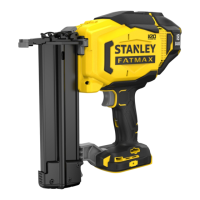
